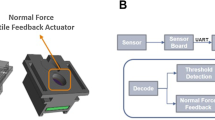Abstract
Background
Vibrotactile feedback (VIB) has been utilized in previous research as sensory augmentation to improve performance during minimally invasive surgical tasks. Stochastic resonance (SR), introduced into the human control system as white noise at a subthreshold level, has shown promise to improve the sensitivity of tactile receptors resulting in performance enhancement for sensorimotor tasks. The purpose of this study was to determine whether SR could improve performance (accuracy, speed) in a simulated laparoscopic palpation task.
Methods
Sixteen subjects performed a palpation task using a laparoscopic tool to detect the presence of tumors (compacted felt) embedded in simulated tissue samples (silicone gel) inside a laparoscopic trainer box. Subjects were randomly assigned to one of the four different conditions: (1) SR, (2) VIB, (3) VIB + SR, and (4) Control. The VIB and SR signals were administered via two separate haptic actuators attached to the subjects’ dominant upper arms and forearms, respectively. All subjects were presented with 36 tissue samples with no sensory augmentation (Control) to establish baseline, followed by another 36 samples under one of the randomly assigned vibration conditions (SR, VIB, VIB + SR, or Control).
Results
Results show a significantly larger improvement in tumor detection accuracy in the SR group compared to the VIB and Control groups. There was no difference in the time to task completion, indicating that there was no speed–accuracy trade-off.
Conclusions
The results have implications for the design of instruments and methods for increasing detection accuracy such as in palpation tasks. This technology could help surgeons better identify tumors located in healthy surrounding tissue.




Similar content being viewed by others
References
Cuschieri A, Buess G (1992) Nature and scope of endoscopic surgery. Operative manual of endoscopic surgery. Springer, Berlin Heidelberg, pp 9–13
Way LW, Stewart L, Gantert W, Liu K, Lee CM, Whang K, Hunter JG (2003) Causes and prevention of laparoscopic bile duct injuries: analysis of 252 cases from a human factors and cognitive psychology perspective. Ann Surg 237(4):460–469
Picod G, Jambon AC, Vinatier D, Dubois P (2005) What can the operator actually feel when performing a laparoscopy? Surg Endosc Other Interv Tech 19(1):95–100
Strasberg SM (2002) Avoidance of biliary injury during laparoscopic cholecystectomy. J Hepato-Biliary-Pancreat Surg 9(5):543–547
Kitagawa M, Dokko D, Okamura AM, Yuh DD (2005) Effect of sensory substitution on suture-manipulation forces for robotic surgical systems. J Thorac Cardiovasc Surg 129(1):151–158
Schoonmaker RE, Cao CGL (2006) Vibrotactile force feedback system for minimally invasive surgical procedures. In: IEEE international conference on systems, man and cybernetics, 2006. SMC’06, vol 3, pp 2464–2469
Zhou M, Cao CGL (2009) Vibrotactile feedback improves laparoscopic palpation skills. In: Proceedings of the human factors and ergonomics society annual meeting, vol 53, pp 738–742
Bholat OS, Haluck RS, Murray WB, Gorman PJ, Krummel TM (1999) Tactile feedback is present during minimally invasive surgery. J Am Coll Surg 189(4):349–355
Bark K, McMahan W, Remington A, Gewirtz J, Wedmid A, Lee DI, Kuchenbecker KJ (2013) In vivo validation of a system for haptic feedback of tool vibrations in robotic surgery. Surg Endosc Other Interv Tech 27(2):656–664
McMahan W, Romano JM, Abdul Rahuman AM, Kuchenbecker KJ (2010) High frequency acceleration feedback significantly increases the realism of haptically rendered textured surfaces. In: Haptics symposium, 2010 IEEE, pp 141–148
McDonnell MD, Abbott D (2009) What is stochastic resonance? definitions, misconceptions, debates, and its relevance to biology. PLoS Comput Biol 5(5):1–9
Kurita Y, Shinohara M, Ueda J (2011) Wearable sensorimotor enhancer for a fingertip based on stochastic resonance. In: 2011 IEEE international conference on robotics and automation (ICRA), pp 3790–3795
Mendez-Balbuena I, Manjarrez E, Schulte-Moenting J, Huethe F, Tapia JA, Hepp-Reymond M-C, Kristeva R (2012) Improved sensorimotor performance via stochastic resonance. J Neurosci 32(36):12612–12618
Collins JJ, Priplata AA, Gravelle DC, Niemi J, Harry J, Lipsitz LA (2003) IEEE noise-enhanced human sensorimotor function. Eng Med Biol Mag 22(2):76–83
Mulavara AP, Fiedler MJ, Kofman IS, Wood SJ, Serrador JM, Peters B, Bloomberg JJ (2011) Improving balance function using vestibular stochastic resonance: optimizing stimulus characteristics. Exp Brain Res 210(2):303–312
Collins A, Blackburn JT, Olcott C, Yu B, Weinhold P (2011) The impact of stochastic resonance electrical stimulation and knee sleeve on impulsive loading and muscle co-contraction during gait in knee osteoarthritis. Clin Biomech 26(8):853–858
Kurita Y, Sueda Y, Tsuji T, Hattori M, Tokunaga M, Egi H, Ueda J (2012) Improvement of tactile sensitivity by stochastic resonance: application to vibrating forceps. In: ASME 2012 5th annual dynamic systems and control conference joint with the JSME 2012 11th motion and vibration conference. pp 465–469
Sueda Y, Hattori M, Sawada H, Egi H, Ohdan H, Ueda J, Kurita Y (2013) Improvement of tactile sensitivity by stochastic resonance effect-Applications to surgical grasping forceps. In: Engineering in medicine and biology society (EMBC), 2013 35th annual international conference of the IEEE, pp 4601–4604
Ai L, Liu J, Liu J (2009) Using auditory noise to enhance the fine-motor of human’s hand due to cross-modal stochastic resonance. In: 2nd International Conference on biomedical engineering and informatics, 2009. BMEI’09, pp 1–4
Liu W, Lipsitz LA, Montero-Odasso M, Bean J, Kerrigan DC, Collins JJ (2002) Noise-enhanced vibrotactile sensitivity in older adults, patients with stroke, and patients with diabetic neuropathy. Arch Phys Med Rehabil 83(2):171–176
Priplata AA, Patritti BL, Niemi JB, Hughes R, Gravelle DC, Lipsitz LA, Collins JJ (2006) Noise-enhanced balance control in patients with diabetes and patients with stroke. Ann Neurol 59(1):4–12
Acknowledgments
This work was supported by a grant from the Ohio Third Frontier to the Ohio Imaging Research and Innovation Network (OIRAIN). The authors acknowledge the assistance of Emily Diller and Katherine Babbitt.
Author information
Authors and Affiliations
Corresponding author
Ethics declarations
Disclosures
Robert D. Hoskins, Jinling Wang, and Caroline G.L. Cao have no conflicts of interest or financial ties to disclose.
Rights and permissions
About this article
Cite this article
Hoskins, R., Wang, J. & Cao, C.G.L. Use of stochastic resonance methods for improving laparoscopic surgery performance. Surg Endosc 30, 4214–4219 (2016). https://doi.org/10.1007/s00464-015-4730-8
Received:
Accepted:
Published:
Issue Date:
DOI: https://doi.org/10.1007/s00464-015-4730-8




